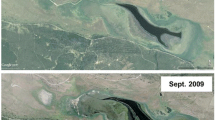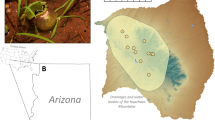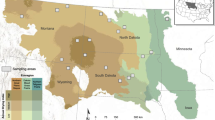Abstract
Context
Occupancy and persistence of amphibian populations in patchy wetland habitats is influenced by landscape heterogeneity, species traits, and hydroclimatic variability. Such information is helpful for understanding the key drivers for reported world-wide declines in amphibian populations over past decades.
Objectives
The overarching goal of this study is to investigate how the combination of dynamic patch habitat attributes, as influenced by stochastic hydroclimatic forcing and landscape heterogeneity, and species traits drive long-term spatiotemporal patterns of wetland patch occupancy for amphibian metapopulations.
Methods
We used a data-model synthesis approach, integrating a long-term record of monitoring for Rana pipiens with simulations using a dynamic stochastic patch occupancy model, which links parsimonious representations of ecohydrological dynamics. Analyzed data were collected over a 20-yr period at the Cottonwood Lake Study Area in the Prairie Pothole Region in North Dakota, USA.
Results
The stability of the mean hydroclimatic forcing during the two decades of amphibian monitoring, and access to dense and diverse wetlands, contributed to persistence of the R. pipiens, despite seasonal spatiotemporal habitat dynamics. The amphibian occupancy pattern simulated for a larger domain surrounding the study area showed that the increased number of wetland habitats dampens variability in patch occupancy, contributing to persistence in the R. pipiens metapopulation.
Conclusions
The proposed framework is useful for understanding how spatial heterogeneity in habitat attributes and temporal variability in hydroclimatic forcing could affect metapopulation persistence in dynamic wetlandscapes. This integrated perspective can then be used to guide monitoring and management strategies based on statistically representative areas of heterogeneous and dynamic wetlandscapes.






Similar content being viewed by others
Data availability
We thank D. M. Mushet, M. J. Solensky and their cooperators that collected the field data used in our paper, and make them freely available in the USGS repository. Their conscientious field work made our paper possible. The data that support the findings of this study are publicly available. Data for wetland hydrological variability as well as for R. pipiens counts in the Cottonwood Lakes Study Area are available at the USGS repository (Mushet and Solensky 2018). Data for wetland dimension and location are available at the National Wetland Inventory website (https://www.fws.gov/wetlands), while the rainfall data can be found at the National Oceanic and Atmospheric Administration website (https://www.noaa.gov).
Code availability
The codes used to analyze the data and generated the results of the manuscript were all written using MATLAB 2020a, and are available upon request.
References
Albanese G, Haukos DA (2017) A network model framework for prioritizing wetland conservation in the Great Plains. Landsc Ecol 32(1):115–130
Babbitt KJ (2005) The relative importance of wetland size and hydroperiod for amphibians in southern New Hampshire, USA. Wetl Ecol Manag 13(3):269–279
Bertassello LE, Jawitz JW, Aubeneau AF, Botter G, Rao PSC (2019) Stochastic dynamics of wetlandscapes: ecohydrological implications of shifts in hydro-climatic forcing and landscape configuration. Sci Total Environ 694:133765
Bertassello LE, Bertuzzo E, Botter G, Jawitz JW, Aubeneau AF, Hoverman JT, Rinaldo A, Rao PSC (2021) Dynamic spatio-temporal patterns of metapopulation occupancy in patchy habitats. R Soc Open Sci 8(1):201309
Bertuzzo E, Rodriguez-Iturbe I, Rinaldo A (2015) Metapopulation capacity of evolving fluvial landscapes. Water Resour Res 51(4):2696–2706
Brown JH, Kodric-Brown A (1977) Turnover rates in insular biogeography: effect of immigration on extinction. Ecology 58(2):445–449
Bunn AG, Urban DL, Keitt TH (2000) Landscape connectivity: a conservation application of graph theory. J Environ Manag 59(4):265–278
Casagrandi R, Gatto M (1999) A mesoscale approach to extinction risk in fragmented habitats. Nature 400:560–562
Casagrandi R, Gatto M (2006) The intermediate dispersal principle in spatially explicit metapopulations. J Theor Biol 239:22–32
Chandler RB, Muths E, Sigafus BH, Schwalbe CR, Jarchow CJ, Hossack BR (2015) Spatial occupancy models for predicting metapopulation dynamics and viability following reintroduction. J Appl Ecol 52(5):1325–1333
Corn PS (2005) Climate change and amphibians. Anim Biodivers Conserv 28(1):59–67
Craighead FL, Vyse ER (1996) Brown/grizzly bear metapopulations. Metapopulations and Wildlife Conservation Management. Island Press, Washington, pp 325–351
Dahl TE (1990) Wetlands Losses in the United States, 1780’s to 1980's. Report to the Congress. U.S. Department of the Interior; Fish and Wildlife Service, Washington, DC
Dudgeon D, Arthington AH, Gessner MO, Kawabata ZI, Knowler DJ, Lévêque C, Naiman RJ, Prieur-Richard AH, Soto D, Stiassny ML, Sullivan CA (2006) Freshwater biodiversity: importance, threats, status and conservation challenges. Biol Rev 81(2):163–182
Eck B, Byrne A, Popescu VD, Harper EB, Patrick DA (2014) Effects of water temperature on larval amphibian predator-prey dynamics. Herpetol Conserv Biol 9(2):302–308
Euliss NH, LaBaugh JW, Fredrickson LH, Mushet DM, Laubhan MK, Swanson GA, Winter TC, Rosenberry DO, Nelson RD (2004) The wetland continuum: a conceptual framework for interpreting biological studies. Wetlands 24:448–458
Ferrière R, Gatto M (1995) Lyapunov exponents and the mathematics of invasion in oscillatory or chaotic populations. Theor Popul Biol 48:126–171
Fortuna MA, Gómez-Rodríguez C, Bascompte J (2006) Spatial network structure and amphibian persistence in stochastic environments. Proc R Soc B 273(1592):1429–1434
Griffiths RA, Sewell D, McCrea RS (2010) Dynamics of a declining amphibian metapopulation: survival, dispersal and the impact of climate. Biol Conserv 143(2):485–491
Hanski I (1994) Patch-occupancy dynamics in fragmented landscapes. Trends Ecol Evol 9(4):131–135
Hanski I, Gilpin M (1991) Metapopulation dynamics: brief history and conceptual domain. Biol J Lin Soc 42(1–2):3–16
Hanski I, Ovaskainen O (2000) The metapopulation capacity of a fragmented landscape. Nature 404(6779):755–758
Hanski I, Schulz T, Wong SC, Ahola V, Ruokolainen A, Ojanen SP (2017) Ecological and genetic basis of metapopulation persistence of the Glanville fritillary butterfly in fragmented landscapes. Nat Commun 8(1):1–11
Heintzman LJ, McIntyre NE (2021) Assessment of playa wetland network connectivity for amphibians of the south-central Great Plains (USA) using graph-theoretical, least-cost path, and landscape resistance modelling. Landsc Ecol 36:1117–1135
Holyoak M, Lawler SP (1996) Persistence of an extinction-prone predator-prey interaction through metapopulation dynamics. Ecology 77(6):1867–1879
Howell PE, Muths E, Hossack BR, Sigafus BH, Chandler RB (2018) Increasing connectivity between metapopulation ecology and landscape ecology. Ecology 99(5):1119–1128
Huang S, Young C, Feng M, Heidemann K, Cushing M, Mushet DM, Liu S (2011) Demonstration of a conceptual model for using LiDAR to improve the estimation of floodwater mitigation potential of Prairie Pothole Region wetlands. J Hydrol 405(3–4):417–426
Keitt TH (2003) Network theory: an evolving approach to landscape conservation. In: Ecological modeling for resource management. Springer, New York, pp 125–134
Klausmeier CA (2008) Floquet theory: a useful tool for understanding nonequilibrium dynamics. Thyroid Res 1:153–161
LaBaugh JW, Rosenberry DO, Mushet DM, Neff BP, Nelson RD, Euliss NH Jr (2018) Long-term changes in pond permanence, size, and salinity in Prairie Pothole Region wetlands: the role of groundwater-pond interaction. J Hydrol 17:1–23
Levins R (1969) Some demographic and genetic consequences of environmental heterogeneity for biological control. Am Entomol 15(3):237–240
Liu G, Schwartz FW (2011) An integrated observational and model-based analysis of the hydrologic response of prairie pothole systems to variability in climate. Water Resour Res 47:W02504
Mackenzie DI (2005) Was it there? Dealing with imperfect detection for species presence/absence data. Aust N Z J Stat 47(1):65–74
Mari L, Casagrandi R, Bertuzzo E, Rinaldo A, Gatto M (2014a) Metapopulation persistence and species spread in river networks. Ecol Lett 17(4):426–434
Mari L, Casagrandi R, Bertuzzo E, Rinaldo A, Gatto M (2014b) Floquet theory for seasonal environmental forcing of spatially explicit waterborne epidemics. Thyroid Res 7(4):351–365
Marsh DM, Trenham PC (2001) Metapopulation dynamics and amphibian conservation. Conserv Biol 15(1):40–49
Mateo R, Belliure J, Dolz JC, Serrano JA, Guitart R (1998) High prevalences of lead poisoning in wintering waterfowl in Spain. Arch Environ Contam Toxicol 35(2):342–347
McIntyre NE, Liu G, Gorzo J, Wright CK, Guntenspergen GR, Schwartz F (2019) Simulating the effects of climate variability on waterbodies and wetland-dependent birds in the Prairie Pothole Region. Ecosphere 10(4):e02711
McKenna OP, Mushet DM, Rosenberry DO, LaBaugh JW (2017) Evidence for a climate-induced ecohydrological state shift in wetland ecosystems of the southern Prairie Pothole Region. Clim Change 145(3–4):273–287
McLean KI, Mushet DM, Sweetman JN, Anteau MJ, Wiltermuth MT (2019) Invertebrate communities of Prairie-Pothole wetlands in the age of the aquatic Homogenocene. Hydrobiologia 1–21
McMenamin SK, Hadly EA, Wright CK (2008) Climatic change and wetland desiccation cause amphibian decline in Yellowstone National Park. Proc Natl Acad Sci 105(44):16988–16993
Miller DA, Grant EHC, Muths E, Amburgey SM, Adams MJ, Joseph MB et al (2018) Quantifying climate sensitivity and climate-driven change in North American amphibian communities. Nat Commun 9(1):1–15
Moilanen A (1999) Patch occupancy models of metapopulation dynamics: efficient parameter estimation using implicit statistical inference. Ecology 80(3):1031–1043
Moilanen A (2004) SPOMSIM: software for stochastic patch occupancy models of metapopulation dynamics. Ecological modelling, 179(4):533–550
Mushet DM (2010) From earth-observing space satellites to nuclear microsatellites: amphibian conservation in the northern Great Plains. North Dakota State University
Mushet DM, Solensky MJ (2018) Cottonwood lake study area—amphibians, U.S. Geological Survey data release. https://doi.org/10.5066/F7X9297Q
Mushet DM, Rosenberry DO, Euliss NH Jr, Solensky MJ (2016) Cottonwood lake study area—water surface elevations. U.S. Geological Survey data release. https://doi.org/10.5066/F7707ZJ6.
Mushet DM, McKenna OP, LaBaugh JW, Euliss NH, Rosenberry DO (2018) Accommodating state shifts within the conceptual framework of the wetland continuum. Wetlands 38(3):647–651
Newman RA (1992) Adaptive plasticity in amphibian metamorphosis. Bioscience 42(9):671–678
Park J, Botter G, Jawitz JW, Rao PSC (2014) Stochastic modeling of hydrologic variability of geographically isolated wetlands: Effects of hydro-climatic forcing and wetland bathymetry. Adv Water Resour 69:38–48
Phillips SJ, Dudík M, Elith J, Graham CH, Lehmann A, Leathwick J, Ferrier S (2009) Sample selection bias and presence-only distribution models: implications for background and pseudo-absence data. Ecol Appl 19(1):181–197
Pither J, Taylor PD (1998) An experimental assessment of landscape connectivity. Oikos 83:166–174
Pittman SE, Osbourn MS, Semlitsch RD (2014) Movement ecology of amphibians: a missing component for understanding population declines. Biol Conserv 169:44–53
Rains MC, Leibowitz SG, Cohen MJ, Creed IF, Golden HE, Jawitz JW, Kalla P, Lane CR, Lang MW, McLaughlin DL (2016) Geographically isolated wetlands are part of hydrological landscape. Hydrol Process 2016(30):153–160
Ray AM, Gould WR, Hossack BR, Sepulveda AJ, Thoma DP, Patla DA et al (2016) Influence of climate drivers on colonization and extinction dynamics of wetland-dependent species. Ecosphere 7(7):e01409
Rinaldo A, Gatto M, Rodriguez-Iturbe I (2020) River networks as ecological corridors: species, populations, pathogens. Cambridge University Press, Cambridge
Rybicki J, Hanski I (2013) Species–area relationships and extinctions caused by habitat loss and fragmentation. Ecol Lett 16:27–38
Semlitsch RD, Bodie JR (1998) Are small, isolated wetlands expendable? Conserv Biol 12:1129–1133
Semlitsch RD, Bodie JR (2003) Biological criteria for buffer zones around wetlands and riparian habitats for amphibians and reptiles. Conserv Biol 17(5):1219–1228
Serran JN, Creed IF (2016) New mapping techniques to estimate the preferential loss of small wetlands on prairie landscapes. Hydrol Process 30(3):396–409
Sewell D, Beebee TJ, Griffiths RA (2010) Optimising biodiversity assessments by volunteers: the application of occupancy modelling to large-scale amphibian surveys. Biol Conserv 143(9):2102–2110
Taylor PD, Fahrig L, Henein K, Merriam G (1993) Connectivity is a vital element of landscape structure. Oikos 571–573
Tischendorf L, Fahrig L (2000) How should we measure landscape connectivity?. Landsc ecol 15(7):633–641
Todhunter PE (2016) Mean hydroclimatic and hydrological conditions during two climatic modes in the Devils Lake Basin, North Dakota (USA). Lakes Reserv Res Manag 21(4):338–350
Turnbull L, Hütt MT, Ioannides AA, Kininmonth S, Poeppl R, Tockner K et al (2018) Connectivity and complex systems: learning from a multi-disciplinary perspective. Appl Netw Sci 3(1):11
Van Meter KJ, Basu NB (2015) Signatures of human impact: size distributions and spatial organization of wetlands in the Prairie Pothole landscape. Ecol Appl 25:451–465
Winter TC, LaBaugh JW (2003) Hydrologic considerations in defining isolated wetlands. Wetlands 23(3):532
Winter TC, Rosenberry DO (1998) Hydrology of prairie pothole wetlands during drought and deluge: a 17-year study of the Cottonwood Lake wetland complex in North Dakota in the perspective of longer term measured and proxy hydrological records. Clim Change 40(2):189–209
Zamberletti P, Zaffaroni M, Accatino F, Creed IF, De Michele C (2018) Connectivity among wetlands matters for vulnerable amphibian populations in wetlandscapes. Ecol Model 384:119–127
Zhang B, Schwartz FW, Liu G (2009) Systematics in the size structure of prairie pothole lakes through drought and deluge. Water Resour Res 45:W04421
Funding
Lee A. Reith Endowment in the Lyles School of Civil Engineering at Purdue University provided partial financial support for PSCR and LEB. LEB acknowledges support from the Environmental Change Initiative at the University of Notre Dame. PSCR acknowledges support from two NSF Grants: NSF Collaboration Research, RIPS Type 2: Resilience simulation for water, power, and road networks, Award# 1441188; NSF Award# 1354900, “Plant adaptation in variable environments”.
Author information
Authors and Affiliations
Contributions
All authors contributed to the conceptualization and implementation of the model. LB and PSCR led the manuscript writing process. All co-authors contributed to expanding the scope of investigations, revision of manuscript drafts, and the final draft submitted for publication.
Corresponding author
Ethics declarations
Conflict of interest
We have no conflicts of interest to disclose.
Ethical approval
Not applicable.
Consent to participate
Not applicable.
Consent for publication
Not applicable.
Additional information
Publisher's Note
Springer Nature remains neutral with regard to jurisdictional claims in published maps and institutional affiliations.
Supplementary Information
Below is the link to the electronic supplementary material.
Rights and permissions
About this article
Cite this article
Bertassello, L.E., Jawitz, J.W., Bertuzzo, E. et al. Persistence of amphibian metapopulation occupancy in dynamic wetlandscapes. Landsc Ecol 37, 695–711 (2022). https://doi.org/10.1007/s10980-022-01400-4
Received:
Accepted:
Published:
Issue Date:
DOI: https://doi.org/10.1007/s10980-022-01400-4




